Portfolio and Projects
Here, I’ll share some of the projects (websites) I’ve managed over the years. I’ve lost count of the exact number—it’s somewhere in the hundreds—but I’ll highlight a few representative examples to illustrate how I work and approach each project. This includes my process for site audits and developing strategies, whether focused solely on SEO or involving full website design or redesign. Over the years, I’ve also managed a significant number of web design and development projects.
I’ll focus primarily on recent work and showcase success stories (in the last 6-12 months), but I’ll also include a few “fails.” Well, not exactly fails—those projects were still successful, just not at the same level. Most people only post the wins, but I believe there’s value in sharing a bit of everything. I’ve learned a great deal from all of these experiences, and as I’ve mentioned throughout this site, my recommendations are grounded in proven practices—on real websites I’ve worked on and strategies I’ve implemented firsthand.
Please note: Some of the websites I’ll reference are disclosed openly, while others remain anonymous, as I haven’t obtained permission from the client or site owner to share them publicly. I also want to add that I’ve managed some of these projects entirely on my own, while others were done in collaboration with my team. For all of them, I created the game plan (usually a six-month roadmap) and delegated tasks to team members who then executed them.
Pet Wellness Online Store
This is an ecommerce business in the pet niche. It sells pet-related products such as probiotics, health supplements, treats, and chews. The site had a solid SEO foundation and strong branding signals, so we focused on low-hanging fruit and areas with the highest potential ROI. We began working on the site in October 2024 and started seeing noticeable results after 3–4 months of active work. Here’s what we worked on:
- New Content Creation – We’ve been adding around 10,000 words of content each month, focused on general pet-related topics. This was a specific client request, as they wanted to rank for broader keywords not strictly tied to pet supplements.
- Contextual & Authority Link Building – 10 backlinks per month: 5 standard guest posts or niche edits, and 5 editorial links acquired through platforms like Featured.com and HARO.com.
- On-Page SEO Optimization – Several key areas were addressed:
- Fixed orphan page issues by building internal links.
- Added more internal links to high-converting “money pages” with clear calls to action.
- Resolved duplicate content issues by removing one page and redirecting it to the other.
- Provided general content recommendations and best SEO writing practices for the internal team.
- Custom Graphics – We’ve added a variety of visual assets, including checklists, tables, and interactive graphics.
- Pinterest Marketing – To diversify traffic sources, we’ve been creating and publishing 30 custom-designed pins each month that link to “money pages.”
After five months of consistent effort across content, SEO, and link building, here are the results (see the report from Google Search Console below):
- Organic Traffic Doubled – Daily clicks grew from around 1,000 to 2,000, with the highest single day reaching 2,000 clicks.
- Top-Performing Content – One of our newly written posts became the second most-visited page on the site in the last 30 days.
- Domain Rating Improvement – The site’s Domain Rating increased from 60 (in September 2024) to 62 (as of March 2025), reflecting the impact of consistent link building and content development.
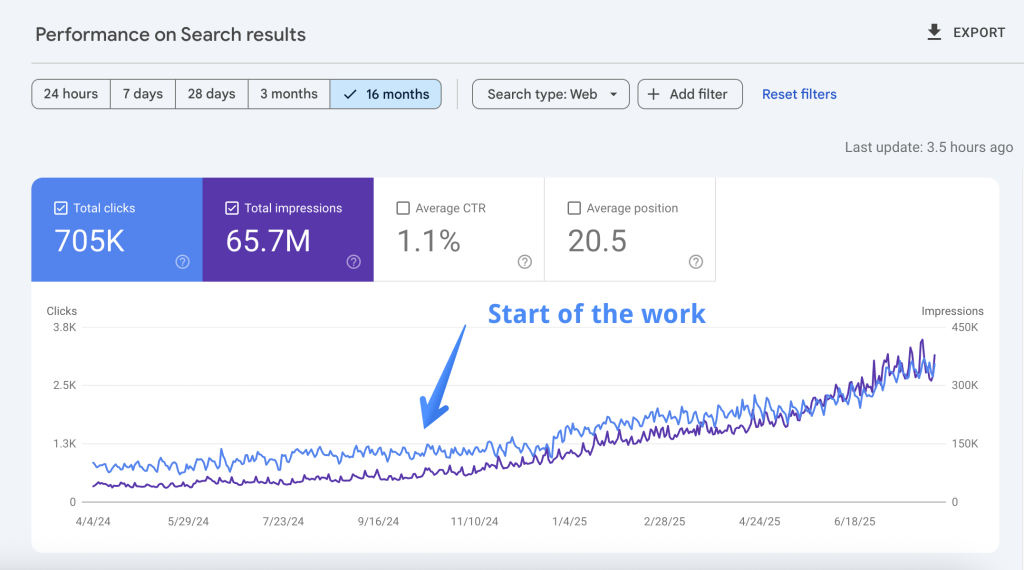
Joy Wallet
This is a personal finance content site (URL: https://joywallet.com) focused on improving financial literacy through articles, guides, and tools. Despite valuable content, it struggled to rank due to Google’s strict E-E-A-T (Experience, Expertise, Authority, Trustworthiness) requirements for YMYL (Your Money, Your Life) topics. Traffic had been declining due to lack of expert contributions, keyword cannibalization, and various on-site SEO issues.
To address this, I brought in financial experts for interviews and added their insights as original content. A full content audit followed—reducing redundancies, consolidating similar articles, and implementing 301 redirects to preserve SEO equity. Technical improvements included better internal linking, unique headings, and deindexing low-value paginated pages.
New content was created based on keyword research and trend analysis, written by niche-specialized writers. I also improved the backlink profile through editorial placements (via HARO and Featured) and guest posting on high-authority financial sites. To diversify traffic sources, I implemented a Pinterest strategy with 30 high-quality pins published monthly.
Results included a clear recovery in traffic and rankings starting August 2024.
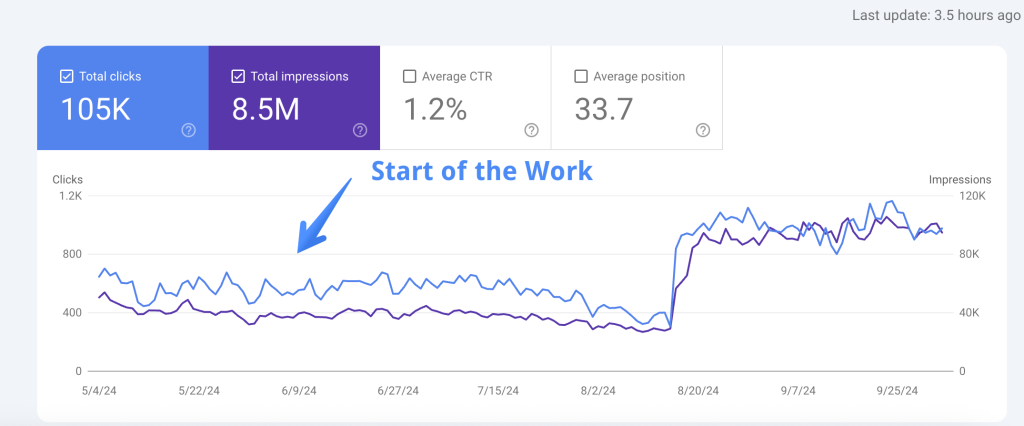
Dentist Website in Houston
This is a local dental website based in Houston, Texas (URL: https://theairwaydentists.com). I’ve been working on this project since October 2024 and am still actively involved. The site initially came to us with numerous issues: duplicate pages (same content) for every service location, along with a range of technical and SEO problems.
We completed a full site redesign using the Bricks Page Builder and launched the new site in February 2025. I collaborated with Reuf Jahic on this project, and we also worked alongside a Creative/Content Manager.
We reduced the number of pages from 35 to 15, focusing on core service offerings, procedures, and pricing. The site now features entirely new design layouts and content copy, while retaining the original logo and brand identity. We also created dedicated location pages for each of the service areas—Sugar Land, Friendswood, and Atascocita—and optimized them for SEO.
In particular, we tailored the location pages based on keyword research. For example, the Sugar Land office had relevant local search demand:
| Keyword | Search Volume |
| pediatric dentist sugar land | 100 |
| preventive dentistry sugar land | 10 |
| emergency dentist sugar land | 90 |
| dental implants sugar land tx | 80 |
| cosmetic dentist sugar land | 30 |
We focused on optimizing these pages for local intent and added strong calls to action directing users to booking pages where patients can easily schedule appointments.
The business already had excellent reviews across its Google Business Profiles, and we further enhanced its authority by updating and expanding the list of services and procedures offered.
We’ve also begun adding blog content—an ongoing process—and continue to build 10 high-quality backlinks per month along with local citations by submitting the site to relevant local directories.
Below is a Google Search Console screenshot showing the website’s performance improvement over the past 12 months.
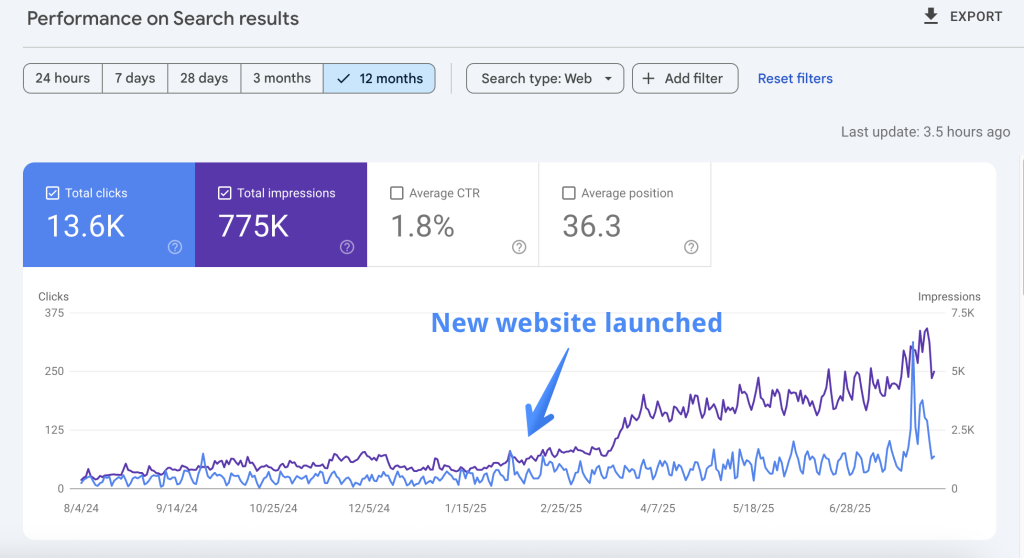
Building & Managing a Business Resource Sites from the Ground Up
I’ve been involved in this project almost from the very beginning and was responsible for nearly every aspect of it. Despite the rollercoaster of traffic and its turbulent performance (which I’ll explain more about below), I’m very proud of what we accomplished. I believe my team and I did a great job. I’ll also share what I would do differently if I were starting again and the key lessons I’ve learned.
Step by Step Business is a website dedicated to entrepreneurs and anyone looking to start a business. It offers in-depth guides on how to launch various types of businesses—covering more than 450 different business ideas—as well as detailed information on LLC formation for all 50 U.S. states. The site also features interviews and case studies with over 350 entrepreneurs from various industries.
As mentioned, I managed every aspect of this project alongside my team: branding, design, content creation, off-page SEO, backlink building, all technical and on-page SEO, as well as Pinterest and a bit of YouTube (though we only scratched the surface there). Around five people were actively involved in the site, including writers, SEOs, and web developers.
We aimed to follow best SEO practices, and I think we did a solid job. Importantly, we didn’t rely on AI—everything on the site was created with human input. However, in hindsight, we focused too much on SEO. The content became overly optimized: headings and FAQs were built strictly around keywords, step-by-step guides followed templated structures, and we pursued aggressive link building. These patterns were likely easy for Google’s algorithms to detect.
The site was on an impressive upward trajectory until September 2023, when Google rolled out its Helpful Content Update—followed by the March 2024 core update. The site was hit hard, losing over 80% of its organic traffic. It’s worth noting that this was still early in the site’s lifecycle, and we had ambitious plans: expanding into social media, growing the YouTube channel, adding more case studies, and even launching an ecommerce store offering business plan templates.
We also believe the site may have been caught in the crossfire. Many high-quality websites experienced similar traffic drops and have yet to recover. Over the past year, the site has seen fluctuating trends. It’s currently showing some signs of recovery, but we’re no longer actively working on it.
In the meantime, we noticed multiple cases where other sites copied our content word-for-word—and still managed to rank higher. Despite making major improvements, deleting hundreds of low-value pages, and optimizing the remaining content, nothing seemed to move the needle. At this point, we concluded it wasn’t an issue of content quality—it was simply that Google’s system had shifted.
The site remains active and still earns decent revenue through affiliate links and display ads. It continues to receive over 500 visits per day from Bing and around 200–300 clicks daily from Pinterest. Other platforms seem to value it—Google, unfortunately, does not. Below is the report from Google Search Console for the past 16 months:

In addition to Step by Step Business, I’ve worked on two other publishing sites in the business niche:
- HumanResource.com – A one-stop hub for all things HR and leadership.
- MakingThatSale.com – A site dedicated to CRM, sales processes, and sales management.
Similar to Step by Step Business, I developed the full concept for both sites, and they are now showing promising progress (see Google Search Console screenshots below).
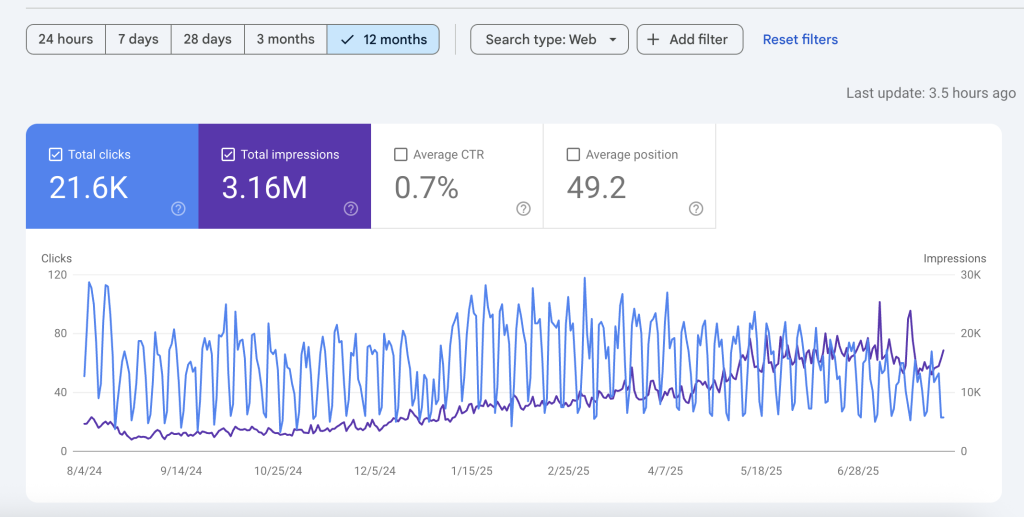
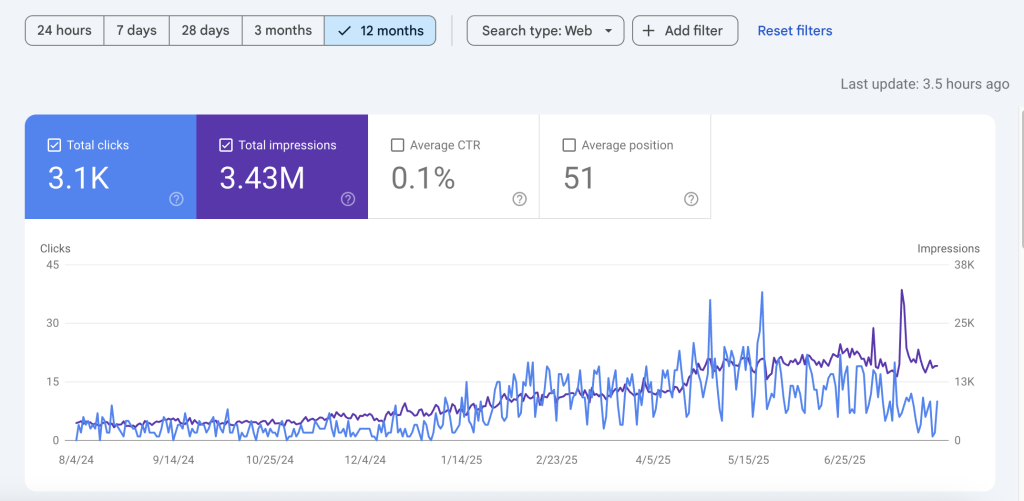
What I would do differently now:
- Instead of over-optimizing for search engines, I’d focus more on brand tone, narrative, and human-first content that stands out—even if it doesn’t check every SEO box.
- I’d steer clear of mass-produced, templated content (e.g., cookie-cutter “How to Start X Business” guides) and instead prioritize unique insights, real examples, and storytelling.
- I wouldn’t rely so heavily on Google. I’d invest earlier in Pinterest, YouTube, and email capture to build audiences that don’t disappear overnight.
- Instead of going wide too fast (450 business ideas, 350 interviews), I’d go deeper on fewer topics to build stronger topical authority and reduce surface-level content dilution.
- I’d add features like quizzes, tools, forums, or email courses to create more user interaction and return visits, building trust beyond just Google referrals.
I don’t think that publishing is dead, but I don’t think the same old concepts still work, especially in the age of AI.
Klima Expert
This is a local website (URL: https://klimaexpert.shop) that sells air conditioners. It came to me a few months ago, although the site itself was built the previous year. I wasn’t involved in the original design, development, content creation, or any other aspect of the build. The owner reached out saying, “My site isn’t getting any traffic.”
The issues were immediately obvious: a large number of non-indexed pages (Discovered – currently not indexed), no sitemap submitted in Google Search Console, paginated page problems, missing meta descriptions, poorly written titles, and more.
Here are some of the basic SEO improvements I implemented:
- Added unique meta titles and descriptions for each product and category (collection) page.
- Optimized image alt text across the site.
- Ensured structured data for product pages was properly configured.
- Grouped products based on manufacturers and key characteristics, and optimized those pages accordingly.
- Created and published 10 blog posts, internally linking them to main product and category pages.
- Requested indexation of key pages in Google Search Console.
These were straightforward, foundational fixes—but critical nonetheless. That said, the site still needs a better overall design and improved loading speed. We’ve agreed to leave those improvements for a future phase.
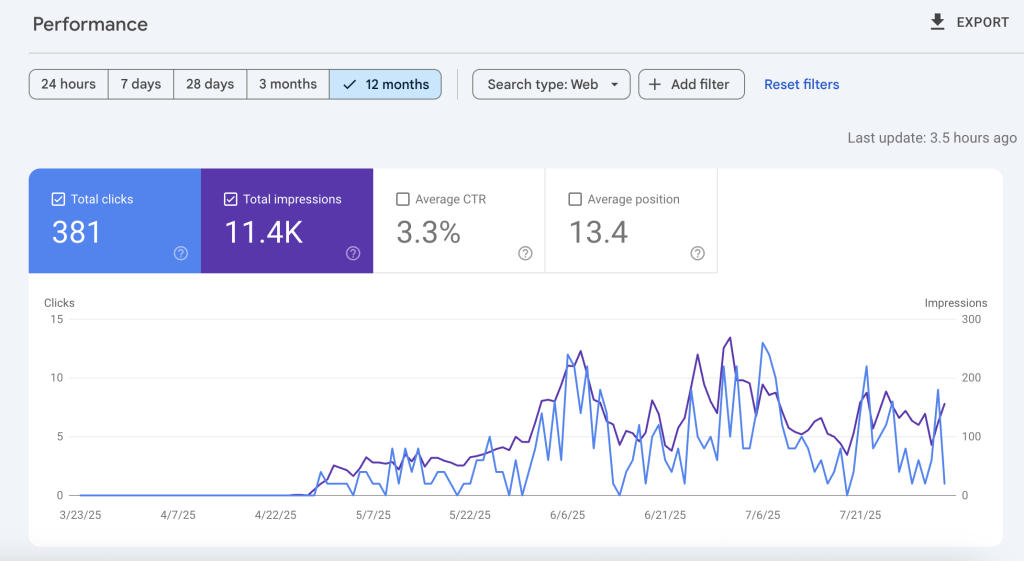
ElektroEnergetik-Ex
This is another local ecommerce website (URL: https://elektroenergetik-ex.com) that sells electric power equipment and tools. It came to me freshly designed, but with no traffic at all.
Only very basic SEO work was done on my end, including:
- Submitting sitemaps to Google Search Console
- Optimizing product pages and product collection pages
The client had one specific request: they wanted to rank for the term “industrijska automatizacija” (industrial automation in English)—and that’s exactly what I delivered.
See the screenshot and Google Search Console report below showing the results.
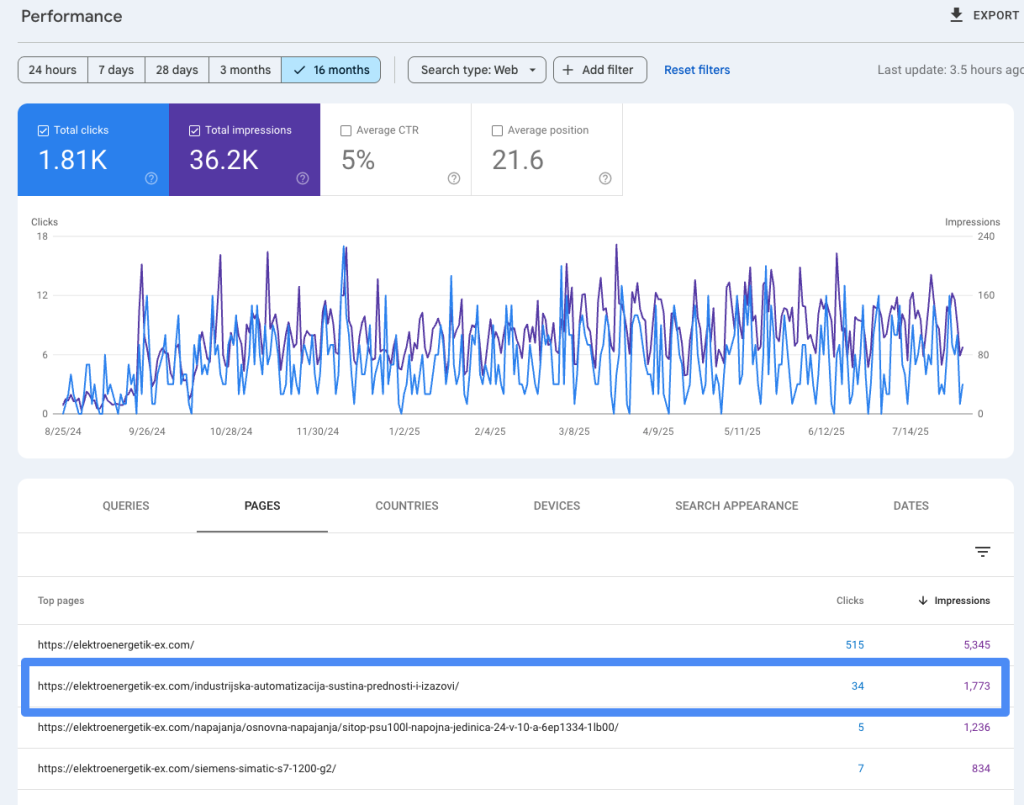
Mobex CIP
This is a local company (URL: https://mobex.co.rs) that manufactures sports equipment, school and office furniture, various metal structures, and also offers cutting, welding, and bending services. The website is quite outdated and in need of a full redesign.
One of my key recommendations was to create a dedicated portfolio page showcasing completed projects. Each project entry would be optimized based on the type of construction and the location where it was installed. For example:
basketball construction in Belgrade
This strategy helps attract visitors searching for similar services in specific cities—even if the company isn’t physically based there—since they offer on-site setup across the country.
Naturally, we also ensured internal linking between each project page and its corresponding main product or product category page to strengthen topical relevance and SEO signals.
In addition to this, I implemented basic SEO improvements:
- Added unique titles and meta descriptions for all main product and product collection pages
- Improved overall site structure and keyword targeting around service locations and offerings
We’ve seen solid results from this localized portfolio-based approach, as shown in the Google Search Console report below.
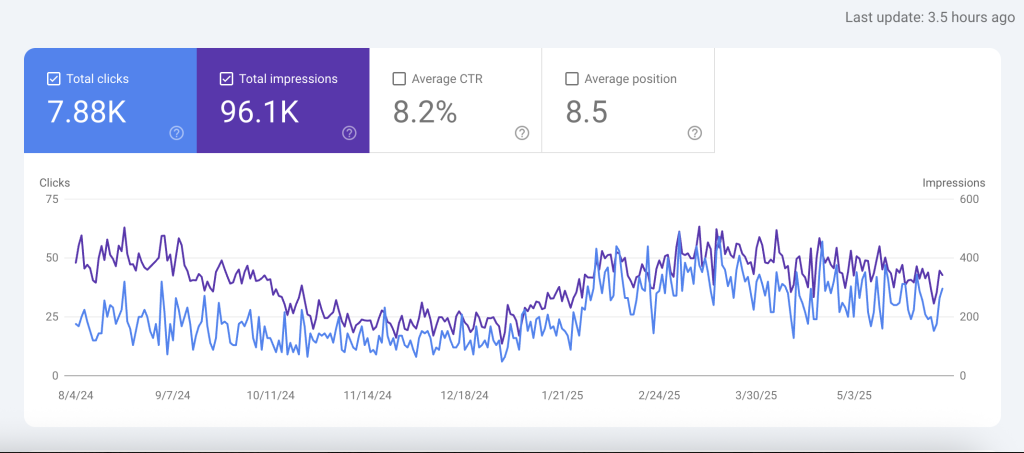
Content-Led Growth in Jewelry eCommerce
This is an ecommerce store that sells high-quality and affordable jewelry, including earrings, necklaces, and bracelets. The website is built on Shopify, so we didn’t make any major technical or design changes. Instead, we focused our efforts entirely on content, SEO, and external visibility.
Here’s what we implemented:
- Link Building – We acquired 5 guest post backlinks and 5 HARO (Help a Reporter Out) links each month to build domain authority and drive referral traffic from relevant editorial sources.
- Pinterest Marketing – Since jewelry and fashion are highly visual and perform exceptionally well on Pinterest, we created and published 50 original, custom-designed pins per month. These pins linked directly to product pages and blog content, helping diversify traffic and improve visibility in this competitive niche.
- Content Creation – We produced around 15,000 words of content per month, focused on informational and transactional search intent (mid funnel and bottom funnel content). Topics included:
- Types of hoop earrings
- How to stack an eternity ring with an engagement ring and wedding ring
- How adjustable rings work
- Engagement ring ideas
- How to stack rings
- How to clean gold-plated jewelry
- How to layer necklaces
- Hoop earring sizes
- How to style huggie earrings
- These topics were selected based on keyword research and user interest, designed to bring in traffic through long-tail keywords and provide helpful, evergreen content.
- On-Page SEO Analysis and Implementation – We performed a full on-page audit and provided actionable recommendations, including:
- Meta title and description optimization
- Internal linking between blog posts and product/category pages
- Image alt text improvements
- Better content structure using clear H1–H3 heading hierarchies
- On-page keyword optimization and user-first formatting
While we didn’t touch the site’s design or technical structure due to platform limitations, these strategic content and SEO efforts significantly improved organic visibility and user engagement.
Below, you can see a screenshot from Google Search Console showing the performance over the last 16 months.
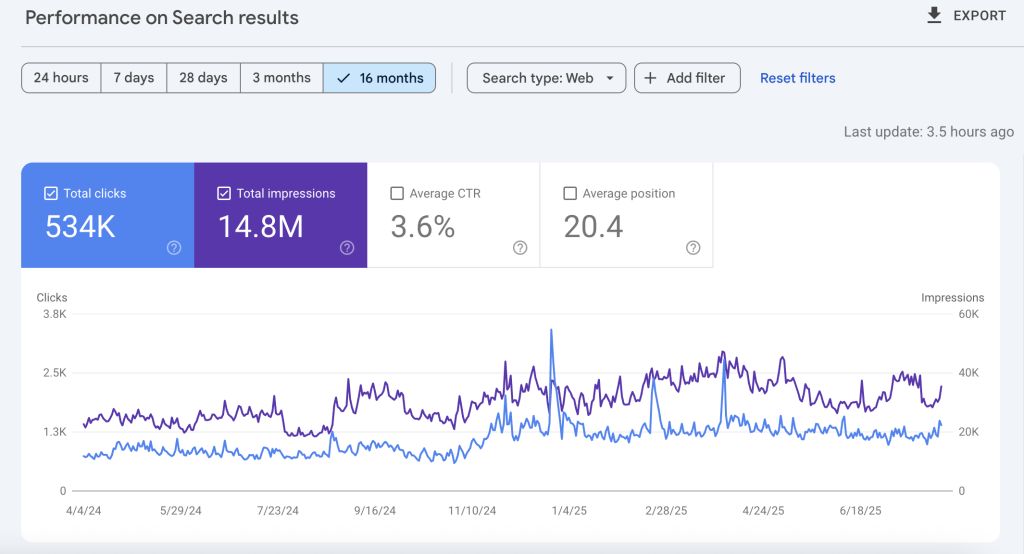
Next Luxury
This is another publishing site I’ve worked on actively. Founded in 2007 as a magazine for the modern gentleman, Next Luxury has grown into one of the largest independent men’s lifestyle websites in the world. Its content spans a wide range of topics including men’s fashion, home design, tattoos, gear, and lifestyle.
At its peak, the site was generating over 2 million views per month, primarily from organic search and Pinterest. However, like many content-heavy websites, it was affected by Google’s algorithm updates—specifically the September 2023 Helpful Content Update and the March 2024 Core Update.
As I’ve mentioned before, this site was heavily SEO-driven. Even though we adopted a multimodal strategy (with over 1 million followers on Pinterest and 200k YouTube subscribers), no site is immune to Google’s changes.
Recently, the site has been showing signs of recovery. Here’s what I did to help:
- Removed low-quality, SEO-driven content – I cut down the number of articles from 6,000 to 3,500, removing overly optimized, keyword-stuffed, thin, or affiliate-heavy pages—especially those that weren’t getting impressions or clicks in Google Search Console.
- Optimized image alt text using AI – Since the site is highly visual, especially in verticals like tattoos, fashion, hairstyles, and interior design, we rewrote descriptive and helpful alt text for thousands of images to improve accessibility and image search visibility.
- Resolved duplicate content issues – Cleaned up overlapping articles, consolidated similar posts, and ensured proper canonical tagging.
- Noindexed paginated pages – Prevented crawl waste and thin content indexing by applying noindex to paginated archive pages.
- Grouped content into clearer topical clusters – For example, tattoo-related content was previously spread across multiple categories. We consolidated all related articles under one optimized category to improve site structure and topical authority.
As of July 2025, the site is trending upward in Google Search Console. We’re cautiously optimistic, and the coming months will show whether the recovery holds.
If your site has been hit by a Google update, consider applying some of these strategies. Having worked on many sites impacted by algorithm changes, I’ve tested dozens of recovery tactics—and this project is a clear example of what’s currently working.
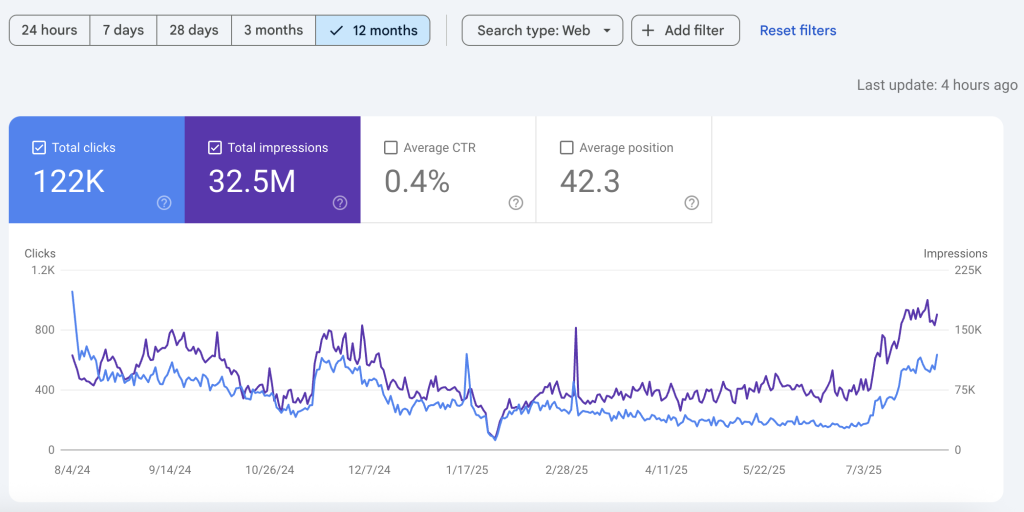
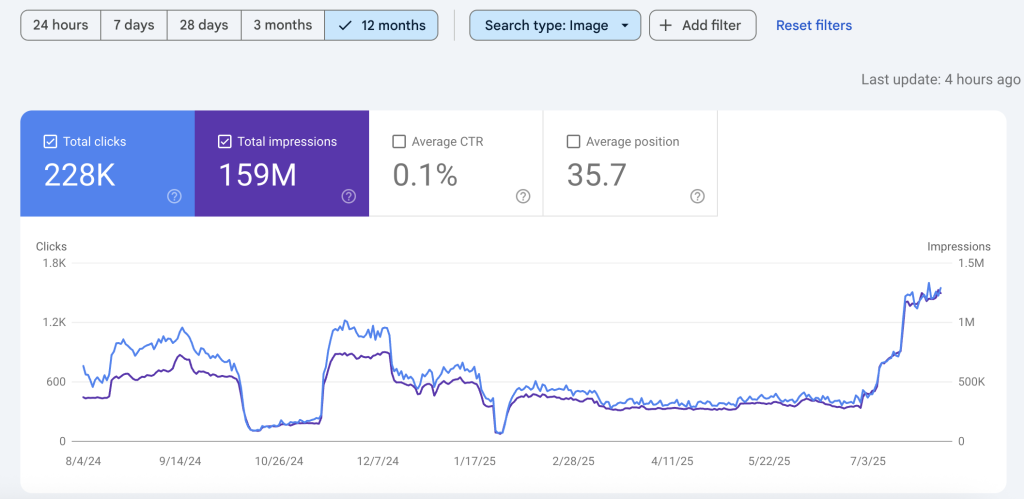
Pinterest and Youtube
I have extensive experience with Pinterest and have helped grow several accounts to more than one million followers. While any visually oriented niche can thrive on the platform, I’ve also achieved strong results in the business niche. The key question, of course, is what really drives Pinterest traffic back to your website. I explain below.
| Area | Why it matters | Practical tips |
|---|---|---|
| Algorithm signals | Pinterest’s Smart Feed scores every Pin against four levers—domain quality, Pin quality, pinner quality and topic relevance. Nail all four and distribution snow‑balls. | • Keep bounce rate low and time‑on‑page high for visitors coming from Pinterest to improve domain quality • Design Pins that earn saves/clicks to raise Pin quality • Pin consistently and engage with others to boost pinner quality • Use keywords in titles, descriptions, board names and image text to hit topic relevance |
| Treat Pinterest like a visual search engine | Searches, not social chatter, drive discovery; keywords, schema and metadata power ranking. | • Start every campaign with Pinterest Trends/auto‑suggest to mine search phrases • Place the primary keyword in the first 40 characters of the Pin title and again in the first sentence of the description • Mirror those terms on the landing page for scent‑matching |
| Pin design = CTR currency | People scroll fast; vertical, high‑contrast creatives outperform. | • Stick to 1000 × 1500 px (2:3) or 1080 × 1920 px for Idea Pins • Add a clear benefit headline on image • Show the product/solution in context; subtle logo bottom‑right • Soft CTA (“Read the guide”) on the Pin itself |
| Freshness & cadence | The algo rewards a steady drip of new images. | • Aim for 3‑5 fresh Pins per day rather than weekly dumps • Create seasonal/“trend‑surfing” Pins 45–60 days before the event • Repurpose blog graphics & short clips into Idea or video Pins |
| Claim the domain & enable Rich Pins | Verification unlocks extra metadata and trust signals that lift CTR and rankings. | • Convert to a Business account, then claim the site • Add OpenGraph or Schema so Article/Product/Recipe Rich Pins auto‑pull headlines, prices, ingredients, etc. |
| Board architecture | First board you save to carries the most SEO weight. | • Build boards around a single keyword theme (“Mid‑Century Home Office Ideas”) • Write 2–3 keyword‑rich sentences in the board description • Pin to the most relevant board first, then repin elsewhere |
| Engagement loops | Saves and comments tell Pinterest a Pin is worth promoting. | • Ask a micro‑question in the description (“Which style is your favorite?”) • Reply to every comment within 24 h • Embed a “Save” button on site images to earn off‑platform saves |
| Diversify formats | Idea Pins (now link‑enabled), short videos and Product Pins grab prime feed real estate. | • Use Idea Pins for tutorials/BTS to rack up impressions • Short (6–15 s) how‑to videos hook users and still link out • Product Pins sync real‑time price & stock for e‑com |
| Measure & iterate | Data beats guesswork. | • Tag outbound links with UTM parameters to separate Pinterest traffic in GA4 • In Pinterest Analytics watch Outbound Click Rate and Saves—optimise low‑click/high‑save Pins with stronger CTAs • Split‑test Pin creatives in Tailwind or ad manager |
| Optionally, amplify | A small budget on Pin ads can jump‑start engagement, improving organic reach after the campaign ends. | • Promote top‑performing Pins at $5–$10/day for 7 days to build early saves and clicks • Retarget previous site visitors with catalog ads for quick wins |
When it comes to YouTube, my focus has been on content production—developing video concepts and scripts, hiring and directing on‑screen talent, and experimenting with AI‑assisted video creation. I coordinate the entire workflow with my team and oversee every stage of production. Growing and monetizing channels is still a new frontier for me, but I’m eager to take on more projects in this space. Below, you’ll find examples of videos my team and I have produced.
Website Design Projects
I’ve contributed to numerous website design and development projects, bringing both strategic SEO insight and practical support. My role typically involves coordinating designers, developers, and SEO specialists while managing timelines and deliverables. Below are a few of the most recent projects.
